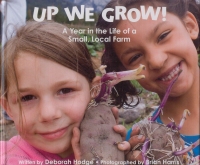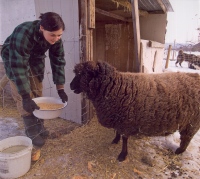| ________________
CM . . .
. Volume XVII Number 6. . . .October 8, 2010 
 |
Up We Grow! A Year in the Life of a Small, Local Farm.
Deborah Hodge. Photographs by Brian Harris.
Toronto, ON: Kids Can Press, 2010.
32 pp., hardcover, $16.95.
ISBN 978-1-55453-561-3.
Subject Headings:
Farms, Small-Juvenile literature.
Farm life-Juvenile literature.
Sustainable agriculture-Juvenile literature.
Organic farming-Juvenile literature.
Grades 1-3 / Ages 6-8.
Review by Gail Hamilton.
*** /4
|
| |
|

excerpt:
Soil is the living dirt that plants grow in. Healthy soil is made up of many things: crumbling rocks, tiny creatures, water, air, and rotting plant and animal matter.
As plants grow, they use up some of the soil's food. The farmers feed the soil and make it healthy by adding compost: a mixture of wood chips, animal manure, and rotted plant and vegetable matter that they collect all year.
Do you have a compost bin?
The farmers place mulch around the plants. This covering of sawdust, straw or reusable plastic keeps the soil moist and warm, and it keeps the weeds away. Some mulches feed the soil, too!
With its emphasis on environmentally friendly farming practices, sustainability, and respecting nature, Up We Grow!, touting the benefits of small farms, describes the work on a farm through the four seasons. The farm (actually a composite of several small farms in British Columbia) produces a mix of nutritious foods, many of them organic, both for human and animal consumption. With the exception of winter, four double-page spreads are devoted to each season. The main body of the text describes the various jobs that the farmers are doing while green fact boxes provide additional general information. Among other things, readers will learn about the relationship between healthy soil and healthy food, the vital link between the farming and the city communities, and the importance of maintaining the land for future generations. One of the strengths of this book is that it showcases the collaboration of several generations of people as they work together to perform the many daily chores on the farm. And, in a world of supermarkets and convenience stores, the book will help children to make the connection between the food on their dinner table and the farmers that grow it.
 In spring, the farm is a busy place as baby animals are born, seeds and seedlings are planted, eggs are collected from the hens, and goat milk is made into cheese. Summer finds the farmers picking and preparing fruits and vegetables to go to market, hoeing weeds, and sowing seeds for winter crops. And, of course, celebrating with food, music and games is part of the annual tradition of giving thanks for the year's bounty. Harvest time in the fall brings a new set of chores: gathering honey from the bee hives and pouring it into jars, taking the last of the fruits and vegetables to the farmers' market in town, collecting seeds for planting next year, composting, and planting cover crops to feed the soil. Finally, in winter, there is time to repair machinery, fences and buildings, to prune trees and to sow seeds in a cold frame. (It is interesting to note that, while there is mention of raising hens for eggs, and goats for milk and cheese, nothing is said about the reason for raising pigs. Perhaps the author felt that young children might be too upset if they knew the source of their morning ham or bacon.) In spring, the farm is a busy place as baby animals are born, seeds and seedlings are planted, eggs are collected from the hens, and goat milk is made into cheese. Summer finds the farmers picking and preparing fruits and vegetables to go to market, hoeing weeds, and sowing seeds for winter crops. And, of course, celebrating with food, music and games is part of the annual tradition of giving thanks for the year's bounty. Harvest time in the fall brings a new set of chores: gathering honey from the bee hives and pouring it into jars, taking the last of the fruits and vegetables to the farmers' market in town, collecting seeds for planting next year, composting, and planting cover crops to feed the soil. Finally, in winter, there is time to repair machinery, fences and buildings, to prune trees and to sow seeds in a cold frame. (It is interesting to note that, while there is mention of raising hens for eggs, and goats for milk and cheese, nothing is said about the reason for raising pigs. Perhaps the author felt that young children might be too upset if they knew the source of their morning ham or bacon.)
Up We Grow! is intended for primary classroom use, to be read by the teacher. Of particular value will be the follow-up discussion. (In fact, the book would be suitable as a prelude to or a review of a class field trip to a farm.) However, the text is too difficult to be read independently by a youngster until the end of the second grade. Illustrations are plentiful and consist of colour photographs taken from different vantage points.
Thoughtfully written in praise of small farms, Up We Grow! successfully provides a look at a busy family-operated enterprise that has an eye to the future.
Recommended.
Gail Hamilton is a retired teacher-librarian in Winnipeg, MB.

To comment
on this title or this review, send mail to cm@umanitoba.ca.
Copyright © the Manitoba Library Association. Reproduction for personal
use is permitted only if this copyright notice is maintained. Any
other reproduction is prohibited without permission.
NEXT REVIEW |
TABLE OF CONTENTS FOR THIS ISSUE
- October 8, 2010.
AUTHORS |
TITLES |
MEDIA REVIEWS |
PROFILES |
BACK ISSUES |
SEARCH |
CMARCHIVE |
HOME |

 In spring, the farm is a busy place as baby animals are born, seeds and seedlings are planted, eggs are collected from the hens, and goat milk is made into cheese. Summer finds the farmers picking and preparing fruits and vegetables to go to market, hoeing weeds, and sowing seeds for winter crops. And, of course, celebrating with food, music and games is part of the annual tradition of giving thanks for the year's bounty. Harvest time in the fall brings a new set of chores: gathering honey from the bee hives and pouring it into jars, taking the last of the fruits and vegetables to the farmers' market in town, collecting seeds for planting next year, composting, and planting cover crops to feed the soil. Finally, in winter, there is time to repair machinery, fences and buildings, to prune trees and to sow seeds in a cold frame. (It is interesting to note that, while there is mention of raising hens for eggs, and goats for milk and cheese, nothing is said about the reason for raising pigs. Perhaps the author felt that young children might be too upset if they knew the source of their morning ham or bacon.)
In spring, the farm is a busy place as baby animals are born, seeds and seedlings are planted, eggs are collected from the hens, and goat milk is made into cheese. Summer finds the farmers picking and preparing fruits and vegetables to go to market, hoeing weeds, and sowing seeds for winter crops. And, of course, celebrating with food, music and games is part of the annual tradition of giving thanks for the year's bounty. Harvest time in the fall brings a new set of chores: gathering honey from the bee hives and pouring it into jars, taking the last of the fruits and vegetables to the farmers' market in town, collecting seeds for planting next year, composting, and planting cover crops to feed the soil. Finally, in winter, there is time to repair machinery, fences and buildings, to prune trees and to sow seeds in a cold frame. (It is interesting to note that, while there is mention of raising hens for eggs, and goats for milk and cheese, nothing is said about the reason for raising pigs. Perhaps the author felt that young children might be too upset if they knew the source of their morning ham or bacon.)